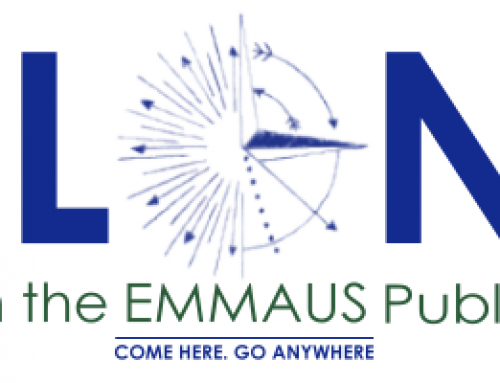View David’s bio and artist’s statement [PDF]. See bottom for links to David’s shop and websites.
When did you know you were an artist?
I think I must have known something as a young child, but it got bludgeoned out of me by a very poor middle school art teacher. Five and a half years ago, I rediscovered my artist self when I began taking classes in the ArtsQuest Glass Studio. After a few months of classes, I took back the identity of artist that had been taken from me years before. I spent most of my life identifying as an Earth scientist and that is still a very important part of my identity. But an early class at Corning with Clare Belfrage helped me see the connections between academic geology and my artistic aesthetic, and was crucial to my being able to integrate my scientific and artistic identities. In the past two years, working closely with local artist and Manager of the ArtsQuest Glass Studio, Dennis Gardner, and taking classes from other artists, including Cat Burns, Ed Branson, Brandon Guy Smith and James Labold, I have developed further in my sense of myself as a glass artist.
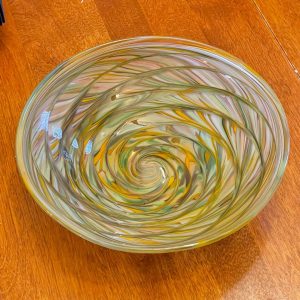 When and why did you decide to pursue it as a career?
When and why did you decide to pursue it as a career?
It took me 4-1/2 of my 5-1/2 years of glassblowing and several sales to begin to accept that people other than me were attracted to what I produced. I believe artists make the world a better place by making their art and putting it on display. I love seeing my art in other people’s homes and lives. I am retired from a successful career in science and education, and I am fortunate indeed that I do not need to sell glass to pay my bills. I make what is interesting to me, but these days I make it with the intention that I will send it out into the world. I have had pieces in a number of juried art shows and I have sold a number of pieces through ArtsQuest events. I have also sold a number of pieces off of Instagram and I now have an Etsy shop. The greatest surprise to me was that I could operate an economically viable and profitable business selling my art.
What’s been your hardest challenge?
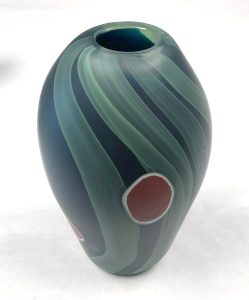 Glassblowing is an incredibly physically demanding art. I am fortunate that I was already working with a very talented athletic trainer when I began. He has helped me meet the physical challenges and kept me healthy and safe. In addition, the medium itself is incredibly challenging. Glass coming out of the main furnace is about the same consistency as room-temperature honey. Just gathering (i.e. getting the right amount of glass on the pipe) is a significant challenge, requiring lots of practice. Thousands of years of glassblowing have left a vocabulary of forms that could easily take a lifetime to master. In addition, every piece of colored glass had different physical properties that must be accommodated — all of which means that there is a lifetime of learning to find one’s voice in the medium. This is both the biggest challenge and the biggest attraction of glass for me.
Glassblowing is an incredibly physically demanding art. I am fortunate that I was already working with a very talented athletic trainer when I began. He has helped me meet the physical challenges and kept me healthy and safe. In addition, the medium itself is incredibly challenging. Glass coming out of the main furnace is about the same consistency as room-temperature honey. Just gathering (i.e. getting the right amount of glass on the pipe) is a significant challenge, requiring lots of practice. Thousands of years of glassblowing have left a vocabulary of forms that could easily take a lifetime to master. In addition, every piece of colored glass had different physical properties that must be accommodated — all of which means that there is a lifetime of learning to find one’s voice in the medium. This is both the biggest challenge and the biggest attraction of glass for me.
What successes or achievements are you most proud of?
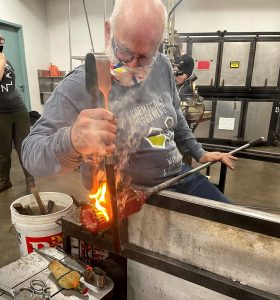 I am most proud of getting to the point where I identify myself as an artist. That was a major transformation for me. It began years ago, but really came to fruition in the past five years. As an artist, the most meaningful pieces to me are those that reference the Earth and its processes in some way. As a geologist working in structure and tectonics (my first career), I am intimately familiar with the chemistry and physics of silicate materials at high temperatures. I love being able to integrate that understanding into aesthetic works and I often described my glassblowing as ‘jazz with magma.’ I am also always incredibly proud of and grateful for the work of my glassblowing teammates and assistants who help to turn my vision into reality. It literally would not be possible without their help.
I am most proud of getting to the point where I identify myself as an artist. That was a major transformation for me. It began years ago, but really came to fruition in the past five years. As an artist, the most meaningful pieces to me are those that reference the Earth and its processes in some way. As a geologist working in structure and tectonics (my first career), I am intimately familiar with the chemistry and physics of silicate materials at high temperatures. I love being able to integrate that understanding into aesthetic works and I often described my glassblowing as ‘jazz with magma.’ I am also always incredibly proud of and grateful for the work of my glassblowing teammates and assistants who help to turn my vision into reality. It literally would not be possible without their help.
What’s your advice for anyone who wants to explore art, but can’t seem to find the time or feels intimidated by a blank canvas?
Don’t let art be defined by what others have told you is art. I firmly believe that art is anything you do that connects your true inner spirit with an aesthetic intention. As you learn, teachers are vitally important, but it is important to find teachers that make space for you to access your spirit and find and pursue your own aesthetic. I’m still totally intimidated by blank pages/canvases in part because I had an art teacher in middle school who taught as though the only worthy path to art was to replicate what she did. I decided that because I couldn’t make a drawing like the drawings in a gallery, I ‘couldn’t draw.’ That set me back years and only the fluid, immediate nature of glass was able to break through that.
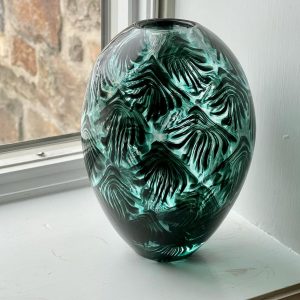 If you sit and stare at the hot glass on the end of a blowpipe, it will turn into a puddle on the floor. You have to do something — quickly. For me that was a gift. Of course my first doings were clumsy and awkward, but I was doing, and from there I just kept on doing. So I think that’s my advice — stop procrastinating or perseverating on the ‘perfect’ and just make a mark, any mark. If you like it, make more marks like that. If you don’t like it, make a different kind of mark and see if you like that one better, and so on and so on.
If you sit and stare at the hot glass on the end of a blowpipe, it will turn into a puddle on the floor. You have to do something — quickly. For me that was a gift. Of course my first doings were clumsy and awkward, but I was doing, and from there I just kept on doing. So I think that’s my advice — stop procrastinating or perseverating on the ‘perfect’ and just make a mark, any mark. If you like it, make more marks like that. If you don’t like it, make a different kind of mark and see if you like that one better, and so on and so on.
My second piece of advice is to go out into the world and notice what attracts your attention. Take time to study those things. What speaks to you in the form, the color, the motion of those things. One big one for me is spring buds and the pent energy about to uncoil into a leaf or a blossom. Not surprisingly, those forms show up in many of my pieces.
My third piece of advice is to try different mediums and find those that allow you to express the things you notice and find meaningful in the world.
And for the record, I still can’t draw like the people whose drawings end up in galleries, and I still catch myself saying ‘I can’t draw.’ But I draw things all the time. I sketch forms for my glass work, I make maps and diagrams, and I can draw totally awesome stick figures. Try to get out of the ‘I can’t’ mode.
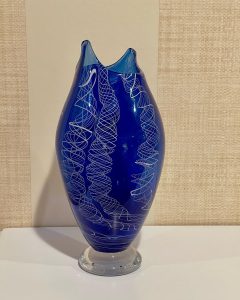 Did the pandemic have an impact on your work or how you work?
Did the pandemic have an impact on your work or how you work?
Definitely! Glassblowing is a team sport. I can work solo if I need to, but I far prefer to have a partner. Traditionally, the assistant blows for the gaffer, or lead artist. But the gaffer had already blown into the pipe. Theoretically, you could disinfect the pipe between people, but very few glassblowers ever did. When we came back after lockdown, we had to learn to use a blowhose, so we were the only people blowing on the pipe for the entire piece. It can be awkward to manage a long rubber hose swinging around as you try to get into or out of the bench as you work, but as we got used to it, we came to appreciate some benefits.
Traditionally, the person making the piece was dependent on the blowing skill of the assistant. With inexperienced assistants, this could be a significant problem. With a blowhose, I am entirely in control of my inflation. If I put too much air into the piece, I have no one to blame but myself. I can be very subtle when I want to, even holding positive pressure but not actually inflating the piece, when needed. Even as others have gone back to having an assistant blow for them, I have continued to use a blowhose.
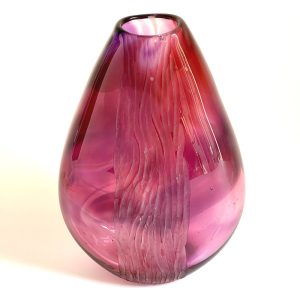 In addition, I bought my own blowpipes and punty rods to reduce my exposure. Shared studio pipes are rarely straight, especially those used by beginners. Having my own pipes and being the only person to use them means that I am completely in control of whether my pipes are straight or not, and it turns out that I am finally skilled enough in my work to really notice the benefit of straight pipes and also skilled enough to keep my pipes straight.
In addition, I bought my own blowpipes and punty rods to reduce my exposure. Shared studio pipes are rarely straight, especially those used by beginners. Having my own pipes and being the only person to use them means that I am completely in control of whether my pipes are straight or not, and it turns out that I am finally skilled enough in my work to really notice the benefit of straight pipes and also skilled enough to keep my pipes straight.
Is there anything else you’d like to share with readers about yourself or your art?
Glass has always occupied the territory between craft and art. Handling hot glass requires the development of high-level technical skills. But getting the most out of furnace-worked glass also requires expressing a personal vision and aesthetic that is appropriate to the medium. In some ways, the debate about art vs. craft is a distraction. Glassblowing is both. In my own work, I work to have the craft (i.e., the technical skills) serve the aesthetic (the art).
[Learn more about Dave Smith and view more of his work on Facebook, Instagram, or Etsy.]
ART@EPL is the library’s exciting partnership with the Lehigh Art Alliance and the Lehigh Valley Arts Council. The series is funded through a grant from PA Partners in the Arts, making it possible for area residents to enjoy free art lectures and workshops from local artists working in pastels, charcoal, sculpture, and watercolor among others.
Visit the ART@EPL page to see all the artists who have led workshops and exhibited work at the library as part of ART@EPL.













